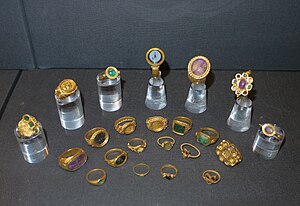Thetford treasure

22 finger rings from the Thetford Hoard
|
|
| Material | gold, silver, gems, shale |
|---|---|
| Size | 33 silver spoons 3 silver strainers 22 gold finger rings 4 gold bracelets 4 necklace pendants 5 gold chain necklaces 2 pairs of necklace-clasps 1 gold amulet 1 unmounted engraved gem 1 emerald bead 3 glass beads 1 gold belt-buckle 1 shale cylindrical box |
| Period/culture | Romano-British |
| Discovered | Gallows Hill, near Thetford, Norfolk, November 1979 |
| Present location | British Museum |
| Identification | P&E 1981 0201 1-83 |
Coordinates: 52°24′N 0°44′E / 52.400°N 0.733°E
The Thetford Hoard (also known as the Thetford Treasure) is a hoard of Romano-British metalwork found by Arthur and Greta Brooks at Gallows Hill, near Thetford in Norfolk, England, in November 1979, and now in the British Museum. Dating from the mid- to late-4th century AD, this hoard is a collection of thirty-three silver spoons and three silver strainers, twenty-two gold finger rings, four gold bracelets, four necklace pendants, five gold chain necklaces and two pairs of necklace-clasps, a gold amulet designed as a pendant, an unmounted engraved gem, four beads (one emerald and three of glass), and a gold belt-buckle decorated with a dancing satyr. A small cylindrical lidded box made from shale also belonged to the hoard.
The find was made under very unfortunate circumstances. The finder was metal-detecting without the knowledge and permission of the owners of the site, which had recently been cleared for building work, and made his discovery late on a November day, in failing light. He recovered the material in great haste, probably overlooking some small items, and because he knew he had no legal right to search in that area, he did not, as the law requires, report his discovery to the authorities. Instead, he unwisely attempted to sell the objects he had found to private buyers. By the time archaeologists learned of the find several months later, the findspot had been built over, making proper archaeological investigation impossible. It was not even possible to question the finder about the circumstances, because by the time the material arrived at the British Museum for study, he was terminally ill, and he died about a month later, in July 1980. Persistent rumours that the treasure originally included coins have never been confirmed or convincingly rejected, but even if there were no coins, it is quite likely that the group as we see it now is incomplete. The full account of the circumstances of the discovery is related in the standard catalogue. This lack of information makes it particularly difficult to speculate on the nature of the hoard and the purpose of its concealment in antiquity.
...
Wikipedia
